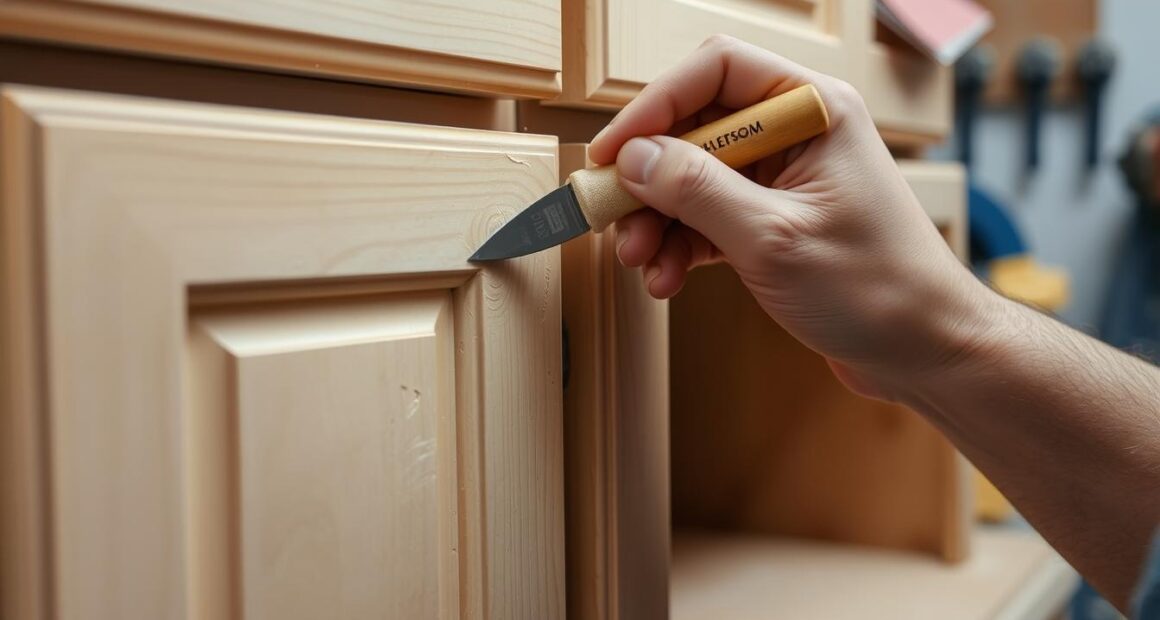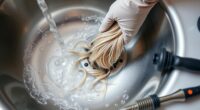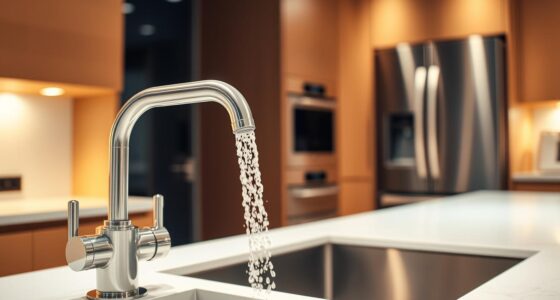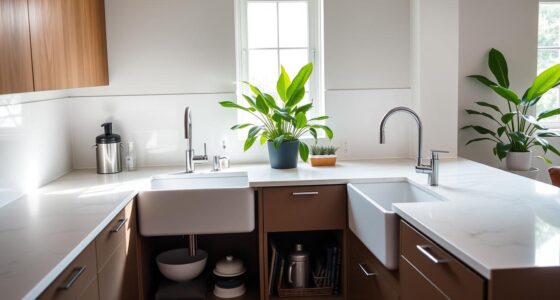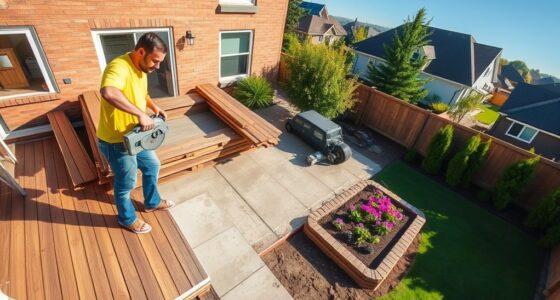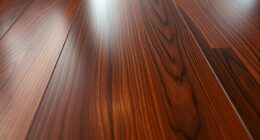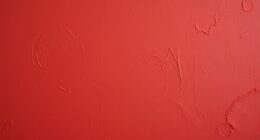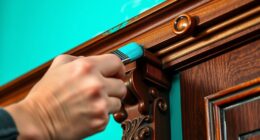Imagine you’re in the kitchen, getting ready to cook for the family. Suddenly, you see the warped edges of your particle board cabinets. It feels like you’re watching your memories of laughter and meals together get damaged. But don’t worry, you can fix this. By using some simple DIY repair tips, you can bring back your cabinets’ beauty and keep those happy moments alive.
Key Takeaways
- Particle board is a common choice in constructing kitchens and lightweight furniture.
- Water damage is the primary cause of deterioration in particle board cabinets.
- Quick identification and repair can prevent extensive damage and costly repairs.
- Proper drying after water exposure is crucial to avoid mold and mildew growth.
- DIY repairs can be effective for minor damage, while extensive issues may require professional help.
Understanding Particle Board and Its Vulnerability to Water Damage
Particle board is often used in construction and making furniture because it’s affordable and versatile. It is made by pressing together wood chips, sawdust, and a special glue. This makes it a less expensive option than solid wood or plywood. It represents about 30% of the engineered wood market. The cost for a sheet of particle board ranges from $20 to $50. But, it has a big downside. It doesn’t handle moisture well.
What is Particle Board?
Particle board doesn’t have the natural grain that solid wood has. This makes it more likely to soak up water. It’s easier to make and change up than other wood products. About 20% of it ends up in places that get wet a lot, like kitchens and bathrooms. This makes it really risky for water damage.
How Does Water Damage Affect Particle Board?
When particle board gets wet, it can swell and warp. This ruins its strength and shape. About 70% of particle board in humid places gets damaged. Leaks from pipes hit around 15% of homes every year. If it isn’t protected, particle board that should last 10-15 years might only last 5-7 years in bad conditions.
There are types of particle board that resist moisture better, but they aren’t always used right. Around 70% of people don’t put waterproof coatings on it. This makes it even more likely to get damaged in wet places. Using a dehumidifier can help prevent half of water damage problems. Knowing about your particle board and keeping your home’s humidity in check is important to keep it in good shape.
Identifying the Source of Water Damage
Knowing how to find where water damage starts is very important. It keeps your particle board cabinets safe. Problems can come from things like leaky pipes, appliance spills, and too much moisture.
Common Causes of Water Damage in Particle Board Cabinets
Sources of water damage need to be recognized early. This can stop big repairs later. Key causes are:
- Plumbing leaks, often happening under sinks
- Spills from things like dishwashers or fridges
- High moisture in places like kitchens and bathrooms
About 29% of homeowners deal with water damage from sink leaks or broken appliances. Catching leaks early is vital to stop home water leaks from getting worse. Checking regularly helps lower these risks.
Recognizing Early Signs of Damage
Spotting signs of particle board damage early allows for quick fixes. Look out for these signs:
- Swelling or twisting of surfaces
- Changes in color or dark spots
- Peeling laminate or veneer
- A musty smell, which might mean mold
Mold can start within 24 to 48 hours after water hits. So, acting fast is crucial. Check areas that get wet often to catch these signs early. This helps your cabinets stay in great shape.

How to Repair Water Damaged Particle Board Cabinets
Repairing water-damaged particle board cabinets may seem tough. But with a clear process, it becomes easier. First, check the damage and dry the area well. Knowing how to repair particle board will give you the confidence to start.
Step-by-Step Repair Process
The repair process typically includes several critical steps:
- Dry the area completely: Use natural air drying methods or a hairdryer to eliminate moisture.
- Sand down swollen areas: Employ medium-grit sandpaper to level out the surface before making any cuts.
- Cut out severely damaged sections: Carefully remove any areas that show significant signs of wear or damage.
- Fill holes with wood filler: Apply an ample amount of wood filler to patches, accounting for potential shrinkage after curing.
- Sand filled areas until smooth: Once dried, utilize fine-grit sandpaper to achieve a uniform surface.
- Seal the repaired areas: Finish with a waterproof sealant to protect against future water damage.
Tools and Materials Needed for Repairs
To effectively execute the repairs, gather the following DIY repair tools and materials:
- Medium and fine-grit sandpaper
- Wood filler
- Putty knife for applying filler
- Hairdryer for the drying process
- Utility knife for cutting damaged sections
- Waterproof sealant to finish the repair
- Protective equipment such as masks and safety glasses
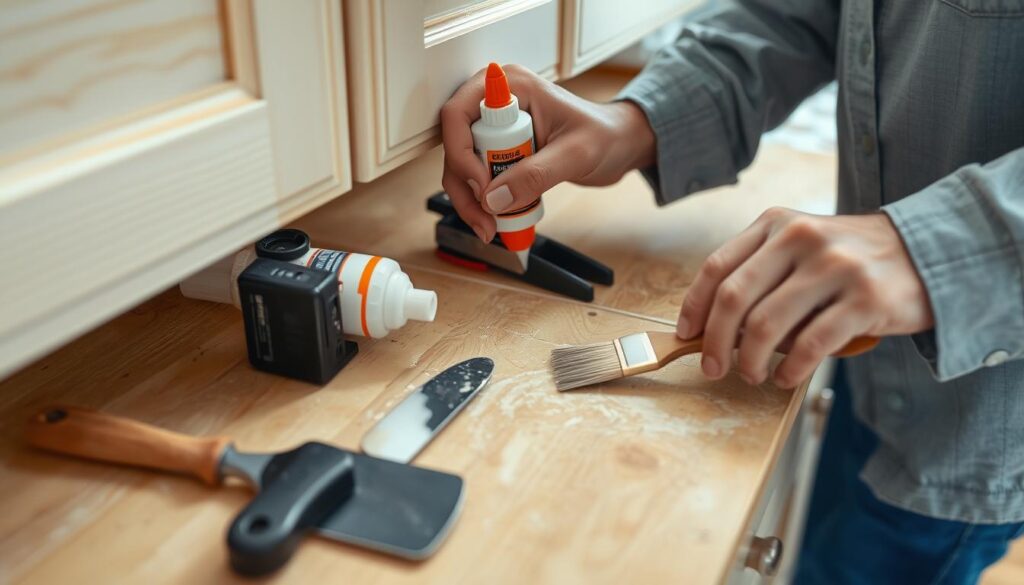
Prepare well and get the right tools for a successful repair. This way, you save time and avoid health risks from mold and mildew.
Preventive Measures to Avoid Future Water Damage
Being proactive in stopping water damage keeps your particle board cabinets in good shape. While fixing damage matters, having a strong prevention plan is even more crucial. This helps keep them in top condition as time goes by.
Sealing and Protecting Particle Board Surfaces
Sealing particle board well is key to stopping water from getting in. Add a waterproof sealant or a cover to all the edges that are open to the air. This step cuts the chance of moisture getting in by about half. Adding a waterproof coating gives an extra shield, reducing damage risks by nearly 40%.
Always check the sealed spots and fix any issues right away. This keeps the protection strong.
Importance of Proper Ventilation in Humid Areas
Good airflow is very important in moist places like kitchens and bathrooms. Poor air movement raises humidity, making particle boards weak. Keeping humidity under 60% is best for avoiding damage.
A strong ventilation system can cut moisture problems by up to 30%. Also, checking your air systems often helps find and fix problems. This makes a space less likely to have water damage.
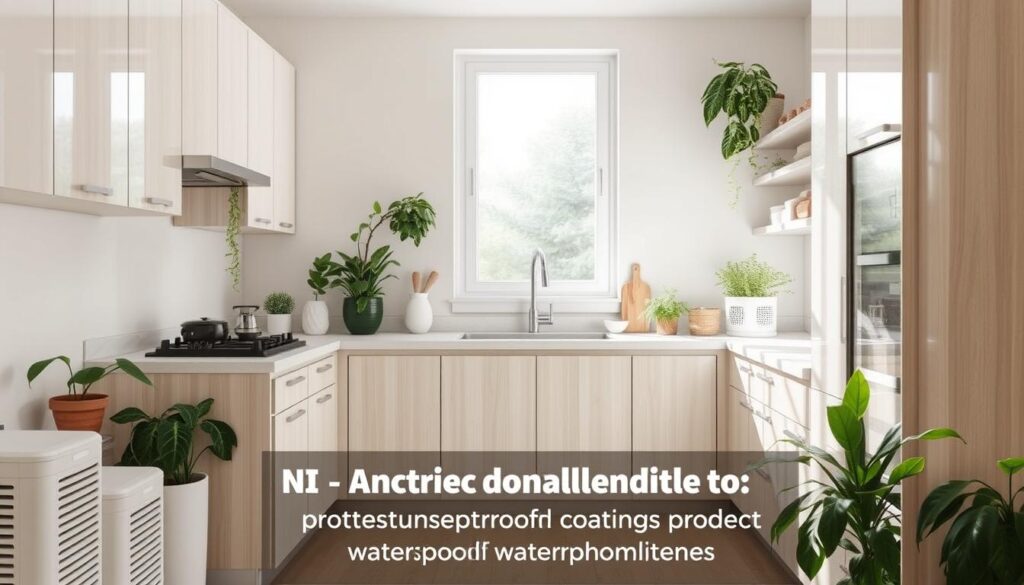
Conclusion
Fixing water damaged particle board is a step-by-step process that needs you to understand why it happens. Kitchens and bathrooms often get damaged by water, which can ruin paint and make laminate surfaces bubble. By keeping up with home care and fixing things right away, your cabinets will last longer.
When fixing your cabinets, try using a shellac-based primer and sand evenly. It’s important to be patient. Oil-based finishes dry slowly, and you might need to apply them more than once to get a smooth look. If you’re careful, fixing water damaged cabinets can make them look and work like new again, brightening up your kitchen or bathroom.
To avoid future water damage, think about using dehumidifiers and sealing edges. These steps can cut the risk of water damage by about 40%. Taking action ahead of time helps you keep your cabinets in good shape. It also makes your home more inviting.
